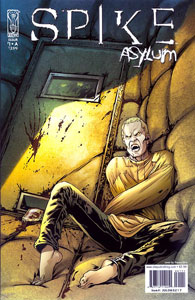I’m generally not a fan of stories about a character (and it’s almost always someone who doesn’t belong there) stuck in prison or an asylum. And I didn’t have good memories of my first read-through of Brian Lynch’s “Spike” and “Angel” work, as I probably always judged him harshly against the fact that Joss Whedon loved his storytelling and hand-picked him to tell the ongoing “Angel: After the Fall” story.
Another thing that made the five-issue “Spike: Asylum” (September 2006-January 2007) a tough sell for me is the continuity confusion. The “Buffy” Wiki says it takes place in “Angel” Season 5, but it includes past-tense references to the time when Angel led Wolfram & Hart, therefore placing it after Season 5. But it turns out the Wiki has a reason for fitting it into Season 5, because the next chronological story, “Spike: Shadow Puppets,” clearly takes place in Season 5.
Continuity problems aside, how does “Asylum” work as a story? Well, it very much fits the template of “protagonist needs to escape from mental institution.” But it’s a strong character piece. Lynch uses internal narration to show us how Spike is feeling, and it works better for him than for Angel, whose brooding nature doesn’t always lend itself to compelling narration (see “The Curse,” for instance). Even though Spike’s nagging need to measure up to Angel gets him thrown in the Mosaic Wellness Center to begin with, both he and the reader realize by the end of “Asylum” how he is different from Angel, and not in a bad way.
Lynch’s characterization of Spike is not only accurate, but also humorous. In Issue 3, Spike is getting beaten up by a large demon when a supervisor finally intervenes. In his inner narration, Spike thinks “Oh, thank you.” Out loud, he says “Oh, damn it. Just when things were getting interesting.” Overall, Lynch peppers in a nice amount of humor to balance out the dark tale and fit well with the later, quippier TV seasons of the Buffyverse.
Rare for Buffyverse spinoff comics, Lynch introduces supporting players who stuck in my mind rather than fading away, and humor is used here, too. The horned demon Anna has had her breasts enhanced to make it in Hollywood, but it doesn’t work because casting directors can’t see past her horns. An invisible inmate, Biv, is staring at her breasts, forgetting that he is partially visible to Anna thanks to her ability to blunt powers.
I remember lots of letter writers expressing their fandom for telepathic floating fish creature Betta George. While his wild design – which wouldn’t have worked on TV – may have turned me off back in the day, I can now see his telepathic banter with Spike is quite entertaining, and this fish-being is essential for Spike learning why he’s in the asylum (Betta George can dig out Spike’s buried memories) and helping him escape.
The fire-demon Beck makes the biggest impact. Although she’s not original – she’s like Drew Barrymore’s “Firestarter” character, or like Oz’s sidekick in “Oz: Into the Wild” but without control of her powers — she fills a gap in Spike’s life that was previously held by Dawn and Fred. Beck is a young woman who Spike feels protective of, someone who – perhaps to his own annoyance – brings out his better nature. (The fairer sex also brings out Spike’s worst nature, as his history shows, and that’s a more interesting internal struggle than his Angel complex.) I want to see more Spike-Beck interactions.

The art by Franco Urru (pencils and inks) and a team of four colorists is another highlight of “Asylum.” Many previous IDW Angelverse books had sparse backgrounds and limited casts, giving me an impression that the writers and artists were taking their shoes off before entering Whedon’s home – they didn’t want to make a mess. “Asylum” has all those aforementioned characters, and just as importantly, the panels feel full — and sometimes messy, in the case of the various demon brawls that break out.
So, although only one additional TV character (Lorne) appears in “Asylum,” and despite the dark subject matter, this is a good read. It digs deeper into the main character than previous “Spike” titles – which capture his personality more on the surface — and adds worthwhile new characters to IDW’s Angelverse, rather than stepping into this world with an overabundance of caution.
Click here for an index of all of John’s “Buffy” and “Angel” reviews.

